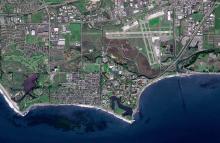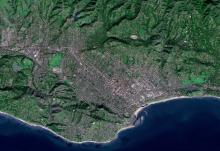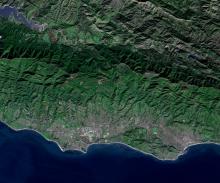Research Partnership Between UCSB and Local Satellite Imagery Company will Open New Frontiers



A collaboration between UC Santa Barbara and a private company, Terra Image USA, headquartered in Santa Barbara, will have a major impact on research that utilizes satellite imagery, according to UCSB scientists.
The partnership agreement will be signed at the university today.
"We're very excited that more than 40 UCSB faculty members, and many more of their students, doing research that utilizes satellite imagery, will have virtually unlimited access to high spatial resolution commercial satellite imagery, a research asset that has previously been available to universities in very limited quantities," said David Siegel, professor of geography and director of UCSB's Institute for Computational Earth System Science (ICESS), the lead university institute involved in the partnership.
"UCSB, like most other universities, has had to rely upon mostly low resolution data sets, such as what NASA provides, which have a resolution of one kilometer per pixel," said Siegel. "What we're getting from Terra Image USA has a resolution 400 times higher, which is comparable to aerial photography and allows one to view and study buildings, trees, cars, and the impacts people make on the Earth. UCSB is already considered among the world's leaders in remote sensing science. Now, with this unprecedented access to high spatial resolution imagery, whole new frontiers of research have been opened for us."
Terra Image USA, the master distributor for the U.S. market of satellite imagery from the SPOT constellation of high resolution Earth imaging satellites, will benefit from the partnership through the promotion of SPOT data for research and the training of future users of SPOT data.
"We are committed to increasing the use of SPOT satellite imagery, including for research purposes," said Mike Hopkins, CEO of Terra Image USA. "Historically, SPOT imagery has had a high cost and restrictive licensing. We have dramatically reduced the cost and loosened the licensing. But making SPOT imagery more accessible is an ongoing effort, and we are working with specific market segments to address their needs. To directly and effectively address the university market, we wanted to start by partnering with a university. UCSB is one of the country's leading Earth remote sensing science programs. It also happens to be in our backyard. UCSB is the ideal partner in this effort and we look forward to building with them a world-class center for multidisciplinary research using SPOT imagery."
Siegel expects to see many new uses of SPOT imagery by UCSB researchers and other university researchers. SPOT can track changes in land use and land cover, vegetation (including wetlands, forests, and agriculture), urban change, transportation, water resources, mineral resources, geomorphology changes, plate tectonics, coastal resources, and much more. "If a volcano erupts or a fire starts, we can request that a satellite be tasked to collect images of that event," said Siegel. Besides current satellite images, researchers will be able to access archival images as far back as 1986, when SPOT first began collecting images.
SPOT images will be useful to UCSB researchers in many departments and institutes, including the departments of:
geography; ecology, evolution and marine biology; geology; and computer science. Spot images will also benefit the Map and Imagery Library, the School of Environmental Science and Management, the Institute for Crustal Studies and the Marine Science Institute.
Siegel, a university leader on this collaboration, describes the mission of ICESS which he directs: "ICESS provides a distributed, interdisciplinary computer environment for the promotion and support of research and research education in Earth system science, and an interdisciplinary environment and computer-related service that enhances the excellence and competitive advantage of UCSB global change research."
###
† About the Illustrations
Images taken by the SPOT 5 satellite on December 25, 2004.
Images are 2.5m resolution natural color display of SPOT 5 imagery (Copyright CNES 2004, distributed by Terra Image USA.)
Related Links



